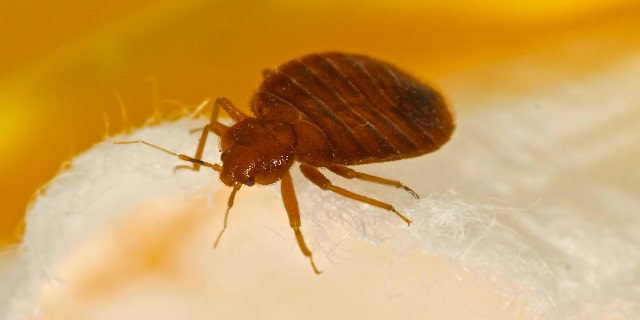Health
Bedbugs could transmit MRSA bacteria that causes staph infections ‘in some settings,’ study suggests

Bedbugs may be able to acquire and transmit methicillin-resistant Staphylococcus aureus (MRSA), according to a recent study published in the Journal of Infectious Diseases.
MRSA is a type of bacteria found on people’s skin that can cause serious infections. In some cases, it can lead to sepsis or even death, according to the Centers for Disease Control and Prevention (CDC).
“Our findings provide the first experimental support for the hypothesis that bedbugs may contribute to the transmission of MRSA in some settings,” Jose E. Pietri, PhD, assistant professor of microbiology at the Sanford School of Medicine at the University of South Dakota, who took part in the research, told Fox News Digital.
AFTER BEDBUG INVASION AT HAWAII AIRPORT, WHAT TO KNOW AND HOW TO RECOGNIZE THE NASTY PESTS
MRSA can cause staph infections, which are challenging to treat due to their resistance to some antibiotics, according to health experts.
Staph infections often spread in health care facilities such as nursing facilities and hospitals, as well as schools and community facilities, they said.
Bedbugs may be able to acquire and transmit methicillin-resistant Staphylococcus aureus (MRSA), according to a recent study published in the Journal of Infectious Diseases. (iStock)
In an experimental study, the group of University of South Dakota researchers conducted three trials using sterile blood surrounded with a collagen membrane contaminated with MRSA at a concentration level that is typically present on human skin.
The researchers allowed the bedbugs to “blood feed” through these contaminated membranes. Then they analyzed the amount of viable MRSA internally and on the surface of the bedbugs over a seven-day period, according to the journal entry discussing the study.
In two of the three trials, MRSA remained viable on the external surface of the bedbugs for up to three days post-exposure.
In two of the three trials, MRSA remained viable on the external surface of the bedbugs for up to three days post-exposure.
In one of the trials, bacteria was detected for up to seven days and was replicated internally.
ANTIBIOTIC RESISTANCE IS ON THE RISE, DOCTOR WARNS: ‘THIS IS AN ENORMOUS PROBLEM’
Seven days later, the researchers looked to see if the bedbugs could transmit MRSA when blood-feeding.
In two of the three trials, the bacteria was transmitted to the uncontaminated membrane.

Several infectious disease experts told Fox News Digital that while the report is interesting, further studies are needed to confirm a link between bedbugs and MRSA outbreaks. (iStock)
“These results do not prove that bedbugs are relevant vectors of MRSA in nature,” Pietri told Fox News Digital.
“Ultimately, additional clinical and epidemiological investigations aimed specifically at examining the relationship between bedbugs and MRSA infections are needed.”
Several infectious disease experts told Fox News Digital that while the report is interesting, further studies are needed to confirm a link between bedbugs and MRSA outbreaks.

MRSA can cause staph infections, which are challenging to treat due to their resistance to some antibiotics. (iStock)
“The study was an experiment using artificial feeders, not people,” noted Dr. Bruce Hirsch, an attending physician in infectious diseases at Northwell Health in Manhasset, New York, who was not part of the study.
“There have been previous associations of exposure to bedbugs to MRSA outbreaks, though very unusual,” he added.
Best practices to prevent infection
The presence of MRSA is very common, Hirsch also told Fox News Digital.
“This germ can cause very serious infections, but usually just colonizes us without any problems,” he said.
“Staph is common in the front of the nose, on skin and around our environment on bedsheets, clothes and nearby objects,” he also said.
“Stay clean, but don’t go crazy.”
There are measures people can take to counter potential MRSA infections, according to the doctor.
He recommends taking steps to stay as healthy as possible.
DANGERS YOU CAN’T SEE MAY BE LURKING IN YOUR UNWASHED BEDDING, SAYS STUDY: BEWARE THE ‘HEALTH CONCERNS’
“Stay clean, but don’t go crazy — too much soap can dry out the skin and make us even more vulnerable to infections,” Hirsch said.
Staph has a sweet tooth, he warned — so people with diabetes should keep their blood sugar well-controlled to reduce the risk of infection.

MRSA is a type of bacteria found on people’s skin that can cause serious infections, in some cases leading to sepsis or even death. (iStock)
“Keeping the immediate environment clean and fresh also helps reduce the burden of bedbugs,” Hirsch added.
Dr. Aaron Glatt, the chief of infectious diseases and a hospital epidemiologist at Mount Sinai on Long Island, New York, was not part of the study but shared comment with Fox News Digital about the findings.
AS LYME DISEASE TESTS MISS MANY ACUTE INFECTIONS, POTENTIAL AT-HOME TEST OFFERS HOPE FOR EARLIER DIAGNOSIS
“This is an experimental study that just supports the potential for bedbugs to theoretically transmit MRSA from one person to another,” he said.
“It does not demonstrate that this is actually occurring in people.”
“There’s certainly no evidence to suggest that this is a major method of MRSA transmission in human beings, but bedbugs are something that can be a nuisance in and of themselves, and infestation should be prevented as best as possible,” Glatt added.
What to know about bedbugs
Bedbugs are “small, flat, parasitic insects that feed solely on the blood of people and animals while they sleep,” the CDC stated on its website.
They are typically transported during travel via luggage, overnight bags or bedding.

One of the telltale signs of a bedbug infestation is bite marks on the face, neck, arms or other body parts after sleeping, according to the CDC. (iStock)
One of the telltale signs of a bedbug infestation is bite marks on the face, neck, arms or other body parts after sleeping, per the CDC.
The bite marks may appear slightly swollen and red, similar to a mosquito bite, and may be itchy and irritating.
CLICK HERE TO SIGN UP FOR OUR HEALTH NEWSLETTER
Other clues that these pests may be present are rust-colored blood spots on the bed (from the blood-filled fecal material the bugs excrete); a sweet, musty odor; and the presence of bedbugs or their exoskeletons found in the folds of the mattress and sheets.
The CDC recommends contacting a pest control specialist to check for bedbugs if any signs appear.

Health
Your July 2024 Horoscope: Zodiac Sign Monthly Forecast | Woman's World

Sign Up
Create a free account to access exclusive content, play games, solve puzzles, test your pop-culture knowledge and receive special offers.
Already have an account? Login
Forgot your password?
Get back to the Sign In
Use left and right arrow keys to navigate between menu items.
Use escape to exit the menu.
Health
Childhood medical myths debunked as experts weigh in on 5 common warnings

Mothers might know best, but it’s not always easy to separate fact from fiction when it comes to health advice.
A new report from University of California San Francisco (UCSF) Health has broken down several common wellness myths that children often hear while growing up.
Fox News Digital spoke with experts who revealed the truth behind common medical misconceptions.
PSYCHOLOGISTS REVEAL 7 WAYS PARENTS CAN DRIVE HAPPINESS BY HELPING KIDS FIND THEIR PURPOSE
Here are five.
Myth 1. Ginger ale relieves stomach aches
While actual ginger can help ease a stomach ache, most commercial ginger ales don’t actually contain the real thing, Michelle Jaelin, a registered dietitian practicing in Ontario, Canada, told Fox News Digital.
A new report from University of California San Francisco (UCSF) Health reveals the truth about several common wellness myths that children often hear while growing up. (iStock)
This childhood myth persists as parents give ginger ale to children because it’s sweet and bubbly, she said.
“It makes parents feel better that they are doing something for their child when they aren’t feeling well, and the myth persisted as a drink that helps a stomach ache,” Jaelin said.
The carbonated beverages could actually make the stomach pain even worse by increasing gas in the digestive tract, according to Healthline’s website.

Chicken soup has been viewed as a popular cold remedy since at least the 12th century, according to the National Institutes of Health (NIH). (iStock)
Drinks with real ginger also tend to contain excess added sugar, experts said – essentially the equivalent of soda that may worsen stomach pain.
Myth 2. Gum stays in your stomach for seven years
“Swallowed gum does not stay in your stomach for [seven] years, as the myths suggest,” Su-Nui Escobar, a registered dietitian based in Miami, Florida, told Fox News Digital.
“While swallowing gum is not recommended, if you do so accidentally, you will likely pass it like any other indigestible food.”
ASK A DOCTOR: ‘IS IT DANGEROUS TO SWALLOW GUM?’
The gum will pass through the stomach within two hours and be excreted in the stool after approximately two to five days, just like other foods, according to the recent UCSF report.
Although chewing gum can stick to many surfaces — including walls or desks — it travels mostly intact through the gastrointestinal tract without sticking to the intestinal walls, the report notes.

“Swallowed gum does not stay in your stomach for [seven] years, as the myths suggest,” an expert told Fox News Digital. (iStock)
But experts still caution against children swallowing gum, because substantial amounts might cause an intestinal blockage, Escobar warned.
This is a particular concern among children who have underlying constipation, according to Mayo Clinic’s website.
“If you suspect a blockage, seek immediate medical attention,” Escobar advised.
Myth 3. You shouldn’t swim for 30 minutes after eating
As summer kicks into high gear, there is good news for any swimmer itching to get in the water after lunch. Yes, it is usually OK to swim right after you eat.
The myth that you shouldn’t swim immediately after eating stems from a theoretical concern that blood flow will be diverted away from the arms and legs to help digest food, potentially leading to an increased risk of drowning.
“Based on current research, eating before swimming is not affiliated with a risk of drowning, and can be dismissed as a myth.”
But a comprehensive American Red Cross scientific review on the effects of eating before swimming showed no effect on performance in the water after a meal.
“A recent literature review did not provide any information related to an increased risk of drowning due to consuming food before swimming,” Jodi Jensen, PhD, member of the American Red Cross Scientific Advisory Council in Virginia, told Fox News Digital.
AS DROWNING DEATHS INCREASE, EXPERTS OFFER WATER SAFETY TIPS
“There is no supporting evidence from a major medical or safety organization that recommends refraining from eating before engaging in aquatic activities such as swimming,” added Jensen, who is also an assistant professor and aquatics director at Hampton University in Hampton, Virginia.

“There is no supporting evidence from a major medical or safety organization that recommends refraining from eating before engaging in aquatic activities such as swimming,” an expert told Fox News Digital. (iStock)
“Based on current research, eating before swimming is not affiliated with a risk of drowning, and can be dismissed as a myth.”
Although study participants experienced “minimal” side effects at different time intervals after eating, some outside experts do recommend waiting a bit after a meal if you plan to swim laps or compete to avoid any stomach cramping or digestive issues.
Myth 4. Chicken soup cures a cold
Chicken soup has been viewed as a popular cold remedy since at least the 12th century, according to the National Institutes of Health (NIH).
ASK A DOCTOR: ‘DOES CHICKEN SOUP REALLY HELP CURE A COLD?’
“Chicken soup is warm and comforting when you’re sick, but it’s not a cure,” Jaelin told Fox News Digital.
“Chicken soup is warm and comforting when you’re sick, but it’s not a cure.”
“Drinking any hot broth when your sinuses are stuffed can help to clear them out.”
The steam from the chicken broth may relieve a sore throat and congested sinuses, the NIH noted.
For more Health articles, visit www.foxnews/health.
When battling a cold, get plenty of clear fluids to help regulate body temperature and promote improved immune system function, said Jaelin.
“Chicken soup counts toward overall fluid intake,” she added.
It also helps prevent dehydration and clear out mucus, the NIH noted.
Myth 5. You will ruin your eyes if you sit too close to the TV
Sitting too close to the TV will not damage your eyes, though it may cause eye strain, according to the American Academy of Ophthalmology.
NEBRASKA BABY BORN WITH CATARACTS HAS 3 EYE SURGERIES TO SAVE HER SIGHT: ‘I JUST KEPT PRAYING’
To prevent eye strain while watching television, experts recommend keeping the room well-lit and taking occasional breaks from the screen.

Sitting too close to the television will not damage your eyes, but may cause eye strain, according to the American Academy of Ophthalmology. (iStock)
“Children can focus at very close distances better than adults, and may not develop the same eye strain symptoms,” Nishika Reddy, M.D., assistant professor of ophthalmology at Moran Eye Center’s Midvalley Health Center at University of Utah in Murray, Utah, told Fox News Digital.
CLICK HERE TO SIGN UP FOR OUR HEALTH NEWSLETTER
It may be a red flag, though, if children are watching television too closely, experts warned.
The behavior may indicate an underlying vision issue that should be addressed, the UCSF report noted.

The American Academy of Pediatrics says high-quality digital media can be introduced to children between 18 and 24 months of age (only when supervised by parents or caregivers). The academy also recommends limiting screen time to one hour a day for children ages 2 to 5. (iStock)
“See an eye care provider to perform an eye exam for your child,” Reddy recommended.
A more concerning issue is the indirect effect of too much screen time, according to the report.
Although experts say there is no one-size-fits-all guideline when it comes to children and screen time, the American Academy of Pediatrics says high-quality digital media can be introduced to children between 18 and 24 months of age (only when supervised by parents or caregivers).
The academy also recommends limiting screen time to one hour a day for children ages 2 to 5.
Fox News Digital reached out to UCSF for additional comment about its new study.
Health
The Anti-Inflammatory and Mediterranean Diets: Two Immune System-Boosting Diets That Don't Skimp on Flavor | Woman's World

Sign Up
Create a free account to access exclusive content, play games, solve puzzles, test your pop-culture knowledge and receive special offers.
Already have an account? Login
Forgot your password?
Get back to the Sign In
Use left and right arrow keys to navigate between menu items.
Use escape to exit the menu.
-

 News1 week ago
News1 week agoNYC pastor is sentenced to 9 years for fraud, including taking a single mom's $90,000
-

 News1 week ago
News1 week agoRead the Ruling by the Virginia Court of Appeals
-

 News7 days ago
News7 days agoTracking a Single Day at the National Domestic Violence Hotline
-

 Politics1 week ago
Politics1 week agoTrump classified docs judge to weigh alleged 'unlawful' appointment of Special Counsel Jack Smith
-

 News1 week ago
News1 week agoSupreme Court upholds law barring domestic abusers from owning guns in major Second Amendment ruling | CNN Politics
-

 Crypto1 week ago
Crypto1 week agoFactors Driving the Evolution of Cryptocurrency Markets
-

 Politics7 days ago
Politics7 days agoSupreme Court upholds federal gun ban for those under domestic violence restraining orders
-

 World1 week ago
World1 week agoOrbán ally-turned-rival joins EPP group in European Parliament















